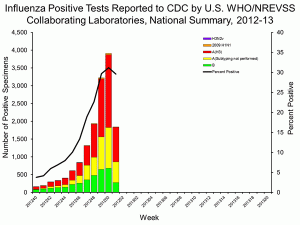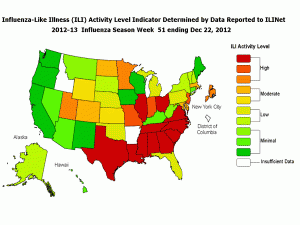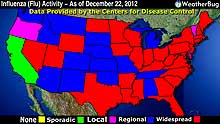It all started when I came down with the flu this December 2012. I did not know I had the flu, I just know that I felt like I was going to die. My symptoms were the following:
- high Fever & sweats
- chills for 2 days
- disorientation
- vomitting
- no appetite
- dizziness
- throbbing headache
- entire body in pain, no comfort
- slept for days
I had time to turn on the ‘boob tube’ during these agonizing few days, and heard nothing on the news, even though my channel surfing scanned every major news network that I could find. I kept wondering how I came down with this “flu” because I haven’t even had so much as a cold in over 12 years. For the record, I haven’t taken an antibiotic since high school, I don’t do vaccines, flu shots or drugs of any kind. So what gives? I decided to get on Facebook and ask the question to see if anyone else was experiencing my symptoms, or at least similar. To my surprise , hundreds of people on Facebook responded with the same symptoms listed above. Yes! They too were feeling the same way, some had been experiencing there illnesses for a couple of weeks, some even longer. So I decided to dig a little deeper. Here is what I have found, and hold tight, because it gets interesting.
I started with the CDC (Center for Disease Control) to see what they were reporting. Here is what they had to say:
2012-2013 Influenza Season Week 51 ending December 22, 2012 (Flue elevated in 11 regions the last week of December 2012)
All data are preliminary and may change as more reports are received.
Synopsis:
During week 51 (December 16-22), influenza activity increased in the U.S.
- Viral Surveillance: Of 6,234 specimens tested and reported by U.S. World Health Organization (WHO) and National Respiratory and Enteric Virus Surveillance System (NREVSS) collaborating laboratories in week 51, 1,846 (29.6%) were positive for influenza.
- Pneumonia and Influenza Mortality: The proportion of deaths attributed to pneumonia and influenza (P&I) was below the epidemic threshold.
- Influenza-Associated Pediatric Deaths: Eight influenza-associated pediatric deaths were reported. Three were associated with influenza B viruses, 3 were associated with influenza A (H3) viruses, and 2 were associated with influenza A viruses for which the subtype was not determined.
- Outpatient Illness Surveillance: The proportion of outpatient visits for influenza-like illness (ILI) was 4.2%; above the national baseline of 2.2%. Nine of 10 regions reported ILI above region-specific baseline levels. New York City and 16 states experienced high ILI activity; 8 states experienced moderate ILI activity; 10 states experienced low ILI activity; 14 states experienced minimal ILI activity, and the District of Columbia and 2 states had insufficient data.
- Geographic Spread of Influenza: Thirty-one states reported widespread geographic influenza activity; 14 states reported regional activity; the District of Columbia and 3 states reported local activity; 2 states reported sporadic activity; Guam reported no influenza activity, and Puerto Rico and the U.S. Virgin Islands.
*If you notice there is no warning or alarm whatsoever, all looks casual and good on the home front. (you can read the rest of the CDC’s page here: http://www.cdc.gov/flu/weekly/)

You can also check out this page and it’s graphs as well http://gis.cdc.gov/grasp/fluview/FluHospChars.html

CHECK here to see if you have the following symptoms:
http://www.cdc.gov/flu/about/disease/symptoms.htm
Influenza Symptoms
Influenza (also known as the flu) is a contagious respiratory illness caused by flu viruses. It can cause mild to severe illness, and at times can lead to death. The flu is different from a cold. The flu usually comes on suddenly. People who have the flu often feel some or all of these symptoms:
- Fever* or feeling feverish/chills
- Cough
- Sore throat
- Runny or stuffy nose
- Muscle or body aches
- Headaches
- Fatigue (tiredness)
- Some people may have vomiting and diarrhea, though this is more common in children than adults.
* It’s important to note that not everyone with flu will have a fever.
Flu Complications
Most people who get influenza will recover in a few days to less than two weeks, but some people will develop complications (such as pneumonia) as a result of the flu, some of which can be life-threatening and result in death.
Pneumonia, bronchitis, and sinus and ear infections are three examples of complications from flu. The flu can make chronic health problems worse. For example, people with asthma may experience asthma attacks while they have the flu, and people with chronic congestive heart failure may have worsening of this condition that is triggered by the flu.
People at Higher Risk from Flu
Anyone can get the flu (even healthy people), and serious problems from influenza can happen at any age, but some people are at higher risk of developing serious flu-related complications if they get sick. This includes people 65 years and older, people of any age with certain chronic medical conditions (such as asthma, diabetes, or heart disease), pregnant women, and young children.
Flu Severity
Flu is unpredictable and how severe it is can vary widely from one season to the next depending on many things, including:
- what flu viruses are spreading,
- how much flu vaccine is available
- when vaccine is available
- how many people get vaccinated, and
- how well the flu vaccine is matched to flu viruses that are causing illness.
I hopped over to the WEATHER BUG and found this report: December 28, 2012
Widespread Flu Covers More Than Half of U.S.
“As we wrap up 2012, the latest flu update has the largest number of states reporting widespread flu so far this season. There are now 31 states – Alaska, Arkansas, Connecticut, Florida, Georgia, Kentucky, Illinois, Indiana, Iowa, Louisiana, Maine, Maryland, Massachusetts, Minnesota, Mississippi, Nevada, New Hampshire, New Jersey, New York, North Carolina, North Dakota, Ohio, Pennsylvania, Rhode Island, South Carolina, Texas, Utah, Virginia, West Virginia, Wisconsin, and Wyoming – that are reporting Widespread Activity. That is 2 more than last week, and more than 60 percent of the the U.S.!”
Dec 30, 2012
NDM-1 “Superbug” Now Acquired in Canada
The emergence of locally acquired NDM-1 in two Canadian hospitals raises concerns about “superbugs” and antibiotics’ future futility.
NDM-1, or New Delhi Metallo-beta-lactamase-1, is actually not a “superbug”, but an enzyme produced by certain bacteria that confer antibiotic resistance. Take this analogy for example: spinach is to Popeye as NDM-1 is to Klebsiella pneumonia. NDM-1 provides this infection with the superbug strength to withstand previously effective antimicrobials. Further underscoring the enzyme’s super powers is the ability of the gene responsible for producing the enzyme to spread unhindered between different types of bacteria. This leaves physicians with few but toxic drugs to treat varying infections, such as E. coli and Salmonella.”
They continue to report :
“NDM-1 bacterial strains have been reported in patients globally, all of who had a history of travel or medical tourism to NDM-1 prevalent areas, such as India. However, two recently released studies on outbreaks of NDM-1 Klebsiella pneumoniae (NDM-1- Kp) in two Toronto-area hospitals are the first of their kind to report the emergence of locally acquired infections.”
Both outbreaks discovered patients who were hospitalized with the drug-resistant bacteria despite no travel history linked to hospitalization or medical treatment in endemic countries.
This drug-resistant version of Klebsiella Pneumoniae spreads quickly and easily in healthcare settings. In the second outbreak, which occurred at the Sunnybrook Hospital in Ontario, it was discovered that the likely source of the outbreak was a shared hand-washing sink.”
“The resistant pathogen spread rapidly from two to seven patients.”
They also claim that “Few existing antibiotics are able to effectively treat these illnesses. For example, strains exist that are susceptible to only two antibacterial agents, colistin which is associated with high rates of kidney toxicity, and tigecyline, which the FDA recently linked to an increased risk of death.”
For more on the resistance , please see the pdf. http://www.nccid.ca/files/Purple_Paper_Note_mauve/PP_33_EN.pdf
Not good , being that most doctors are prescribing antibiotics for the flu. We all know that the antibiotics are not working in most cases…..the bugs are resistant, hence the term SUPER-BUG.
Any logic to the antidote?
We did speak with Dr. Wil Spencer at http://bodyelectrician.com/chelation.html We asked him what his take on the flu is and what should we do about it. Of course the answer is simple, but lengthy.
He believes the body can heal itself with the correct nutrition. He first recommended Chelation Therapy. Dr. Spencer believes that “You can reverse and heal the toxic effects of chemical exposure, as well as heavy metal poisoning and the infections and illnesses resulting from prolonged exposure to any and all of these harmful elements.
The human body is a natural detoxifier and it both feeds and cleans itself through its own natural inner chelation process. This is a simple, natural function which the body is unable to complete because it does not get the raw materials it needs. “
For more information on Arizona’s 2012-2013 influenza and RSV activity, please see the weekly activity reports below.
Updated: Friday, 28 Dec 2012, 6:11 PM EST
http://www.wtnh.com/dpp/news/health/flu-outbreak-across-the-state
World Wide Tracking : http://www.nccid.ca/influenza
Dr. Wil Spencer is a regular guest on The Truth Denied Talk Radio. Please tune in every Tuesday evening at 8-10 PM EST




[…] Flu Outbreak CDC reports antibiotic resistant SUPER BUG […]
Great work at the ranch. Need helpfor a sick friend can you help?.
e can put you in touch with someone, just write us at info@thetruthdenied.com and we will get your friend some help!
Chelating agents were introduced into medicine as a result of the use of poison gas in World War I. The first widely used chelating agent, the organic dithiol compound dimercaprol (also named British anti-lewisite or BAL), was used as an antidote to the arsenic-based poison gas, lewisite. .,-”
View the most popular write-up on our very own blog
http://www.calaguastourpackage.com/index.php
I have you bookmarked to check out new stuff on this post
I am very healthy, eat organic etc but I travelled on a plane and came home with a scrathy throat as my vocal chords were infiltrated. As soon as I felt the tickle I dosed with oil of oregano and felt better. Now my body is dealing with the aftermath of the attack, tiredness, slight chills. I am taking vit C, D and seaweed plus rice and simple veggies and feel I am over the worst. Now it is just a matter of time. Many in Canada have it and it too will pass.
[…] Flu Outbreak CDC reports antibiotic resistant SUPER BUG […]
I create my own capsules of two parts cayenne pepper and one part Golden Seal powder (expensive). I take one with each of two of the day’s meals. Plenty of Vitamin D and C also. Get some sun daily, and lots of sleep, placing under the tongue a throat lozenge made of Vitamin C and Zinc and Bee Pollen. Stay away from ALL dairy, and avoid breads/grains as best you can. For a gargle in case of sore throat, place Bloodroot in boiling non-tap water for 3 minutes, let steep for 20-30 minutes. Strain, and if too cool, warm carefully to desired temp and gargle. DO NOT MICROWAVE. Eat two fresh cloves of garlic with each appropriate meal. Don’t overeat if you have a cough, and stay away from heavy foods. Steam vegetables and coat with a mixture of olive oil, apple cider vinegar, kelp, and cayenne pepper. Mornings: Hot chamomile tea, followed later by fresh fruit. Do not mix melon with other fruit. Comfrey Root, Golden Seal, and Vervain are also useful as teas. Add Hops for cough. Valerian Root capsule, one at bedtime, helps with fever. Chicken soup! Avoid the chicken skin. Stir-fry vegetables with TURMERIC and olive oil, and add to your desired dish, such as steamed brown rice. If you are overweight, do a partial cleanse of the intestines while you are sleeping at night by placing a teaspoon of Psyllium Seeds, a tablespoon of Psyllium Husks, and a tablespoon of liquid Bentonite in 16 ounces of non-tap water. The seeds germinate immediately, so drink it down as fast as you can. Follow up with a glass of non-tap water in about 20 minutes, and go to bed. Have hot tea, and a light breakfast of fresh fruit and hot cereal, and drink water throughout the day.
This sounds awesome!!!!!!!!!!!!!!!!! Thanks so much for sharing it!
Fortunately, we ARE and HAVE made a difference. Thank you for your time.
All viruses are antibiotic resistant, because antibiotics treat bacterial infection, not viruses. Please do not allow your ego to be hurt when I suggest that you need to tackle your ignorance on the subject. This type of ignorance is a real threat – the more we use antibiotics inappropriately, the more likely we are to encourage resistant bacterial strains. If you are going to research a subject, please don’t add to the torrent of dis-information we are all subject to every day of our lives, add something meaningful, valuable and carefully researched. Please expend your efforts wisely, it is clear that you want to make a difference.
Hi Roxy,
Sorry to hear about your illness. I have to agree with the CDC. The Flu Shot will not give you the Flu. They aren’t lying on that one. They didn’t say: The Flu Shot will not give you a military grade laboratory infection. It’s all in the wording. Like “influenza-associated” and “Influenza-Like Illness”. These are legal weasel words and they use them specifically for that purpose. A lot of people I know have had serious illness like what you described. I get sick just going out into public and getting within ten feet of morons who were stupid enough to volunteer for being shot with military grade laboratory infections then go on to shed them like a Persian cat sheds hair. Do a search on who holds the vaccine patents and who makes the recommendations for those vaccines. I was shown a trick on how to read maps: when there is a spread pattern just project a likely focal point, like, say the CDC offices and then fan outward. Both maps fit the pattern.
Doh! All those stats and recomendations??? So what is this article about? What is the point you are trying to make?
Its old news. Flu is a virus and you don’t treat a virus with antibiotics. Antibiotics are for bacterial infections. In other words the complications that can arise from getting flu.
There are a growing number antibiotic resistant bacteria. These have developed mainly through the overuse of antibiotics, because people are uninformed about anitibiotics and so take them to cure about of flu or other viruses that they don’t stand a chance of curing. There is no cure for flu or the common cold.
This is well documented.
Unfortunately, no new antibiotics have been found in recent years.
We have some level of flu epidemic roughly every 4 years. There will be some deaths as a result of the complications that occur.
Flu is a mutating virus, it changes every year and there are many common strains. The flu vaccine in any one year will only combat the most common virus in that year.
It is not unusual to see wide variations in reporting of flu. Influenza is not, a notifyable illness. Most people will just go to bed and ‘hibernate’ when they have it, until they start to feel better.
People don’t usually die from flu. Weaker more frail people such as the very young or the elderly, may die from complications such as melingitis or pneumonia, which can quickly overcome the patients immune system unless it’s contained quickly by antibiotics. Antibiotics do still work on bacterial infections.
Unfortunately, it is not only the young and the frail that are dying, and the Flu is no longer the point. Groups like the CDC report it as a flu because of the symptoms, fact is, the symptoms are more related to nutrition, a systemic issue , lowering our immune systems…..
keep in mind, alot of these statistics could be from better reporting,
more than anything sinister.
and again, im more worried about everyone’s compromised immune systems not so much what is viruses are out there.
no one is implying ‘sinister’